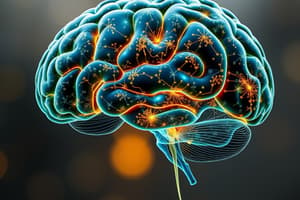Podcast
Questions and Answers
What is the difference between biological, cognitive, and socioemotional development?
What is the difference between biological, cognitive, and socioemotional development?
Biological development refers to physical growth, cognitive development involves mental processes like thinking and learning, and socioemotional development encompasses emotions and relationships.
What is the first stage of Erikson's psychosocial theory of development?
What is the first stage of Erikson's psychosocial theory of development?
- Initiative vs. Guilt
- Trust vs. Mistrust (correct)
- Autonomy vs. Shame and Doubt
- Industry vs. Inferiority
What is Bronfenbrenner's ecological theory of development?
What is Bronfenbrenner's ecological theory of development?
It is a theory that emphasizes the multiple layers of environmental influences on development, including microsystem, mesosystem, and exosystem.
As the benefits of evolutionary selection increase with age, the need for culture decreases.
As the benefits of evolutionary selection increase with age, the need for culture decreases.
What does DNA stand for?
What does DNA stand for?
What is the definition of teratogen?
What is the definition of teratogen?
What are the three stages of prenatal development?
What are the three stages of prenatal development?
What is the difference between fraternal and identical twins?
What is the difference between fraternal and identical twins?
What is the APGAR test?
What is the APGAR test?
What are the four lobes of the brain?
What are the four lobes of the brain?
What is infantile amnesia?
What is infantile amnesia?
What are Chess and Thomas's three temperament styles?
What are Chess and Thomas's three temperament styles?
What does receptive vocabulary refer to?
What does receptive vocabulary refer to?
Flashcards are hidden until you start studying
Study Notes
General Tips
- Email or visit office hours for any questions—no question is unworthy.
- Lowest exam score will be dropped.
- Stay calm and confident in what you know.
The Lifespan Perspective (Section 1)
- Understand differences in biological, cognitive, and socioemotional development.
- Distinction between chronological age (actual age) and biological age (physical condition).
- Nature vs nurture: the debate around genetic inheritance versus environmental influences.
- Erikson's psychosocial theory: first stage is trust vs mistrust; second stage is autonomy vs shame and doubt.
- Bronfenbrenner's ecological theory includes multiple systems: microsystem (immediate environment), mesosystem (interconnections), exosystem (indirect influences), macrosystem (cultural context), and chronosystem (time-related influences).
- As evolutionary selection benefits decline with age, cultural needs grow.
Beginnings (Section 2)
- DNA is a double helix structure containing genetic information.
- Fertilization occurs when an egg and sperm combine.
- Phenotype refers to observable characteristics shaped by genotype.
- Susceptibility and longevity genes affect individual resilience and lifespan.
- The epigenetic view emphasizes gene expression modulation by environmental factors.
- Teratogens are harmful substances that affect prenatal development (e.g., alcohol, drugs).
- Proximodistal development: growth from the center outward; cephalocaudal development: growth from head to toe.
- Postpartum depression is a mood disorder affecting mothers after childbirth.
- In-vitro fertilization (IVF) involves egg fertilization outside the body.
- Prenatal development consists of three stages: germinal, embryonic, and fetal.
- Fraternal twins originate from two separately fertilized eggs; identical twins arise from one fertilized egg that splits.
- Passive genotype-environment correlation occurs when genetic predispositions influence the environment; evocative correlations occur when individuals elicit responses from their environment; active (niche-picking) correlations involve choosing environments that suit genetic predispositions.
- Understand the key events of the third stage of the birth process.
- The APGAR test evaluates newborns for health and wellness immediately after birth.
- The brain has four lobes:
- Frontal (decision-making, problem-solving),
- Parietal (sensory perception, spatial orientation),
- Occipital (vision),
- Temporal (hearing, memory).
- Normative age-graded influences are age-related events (e.g., menopause); normative history-graded influences affect many individuals at a specific time (e.g., Great Depression); non-normative events are unique to individuals (e.g., death of a parent).
Infancy (Section 3)
- Reflexes include:
- Moro (startle reflex),
- Rooting (turning towards touch on cheek),
- Sucking (for feeding),
- Grasping (holding onto objects).
- Gross motor skills involve large movements (e.g., crawling); fine motor skills involve small movements (e.g., grasping).
- Pincer grasp uses thumb and forefinger; palmer grasp uses the whole hand.
- Implicit memory is unconscious; explicit memory is conscious recall.
- Infantile amnesia refers to the inability of adults to retrieve memories from early childhood.
- Receptive vocabulary consists of words understood; spoken vocabulary includes words used verbally.
- Piaget's cognitive processes:
- Assimilation (incorporating new info into existing schemas),
- Accommodation (modifying schemas with new information).
- Object permanence is recognizing that objects continue to exist even when unseen.
- The visual cliff experiment assesses depth perception in infants.
- Chess and Thomas identified three temperament styles: easy (adaptable and cheerful), difficult (irritable and intense), and slow to warm up (low activity and mild reactions).
- Strange Situation assessment determines attachment styles, highlighting secure attachment (comfortable with exploration) and insecure-avoidant attachment (minimal emotional response).
Studying That Suits You
Use AI to generate personalized quizzes and flashcards to suit your learning preferences.




